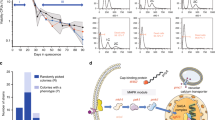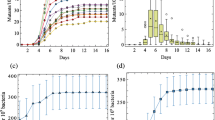Abstract
The frequency of reversion in a histidine-requiring mutant of Saccharomyces cerevisiae increases about ten-fold in stationary cells during histidine starvation. Histidine starvation enhances a similar frequency of reversion in a tryptophan-requiring mutant. Starvation, therefore, enhances mutation frequencies in a non-adaptive manner. The base analogue 6-N-hydroxylaminopurine (HAP) added prior to plating on medium with limited histidine strongly increases reversion of the histidine mutant. HAP-induced reversion increases further in stationary starving cells with the same kinetics as that which increases spontaneous reversion. Adding HAP to the stationary starving cells does not produce any effect.
Similar content being viewed by others
Author information
Authors and Affiliations
Additional information
Received: 25 February 1998 / 5 January 1999
Rights and permissions
About this article
Cite this article
Marini, A., Matmati, N. & Morpurgo, G. Starvation in yeast increases non-adaptive mutation. Curr Genet 35, 77–81 (1999). https://doi.org/10.1007/s002940050435
Issue Date:
DOI: https://doi.org/10.1007/s002940050435




